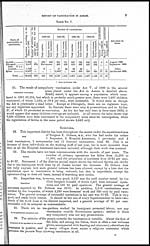Medicine - Vaccination > 1874-1927 - Annual vaccination report of the province of Assam > Vaccination report Assam 1874-1896 > 1886-1887 - Annual vaccination report of the Province of Assam for the year 1886-87
(214) Page 10
Download files
Individual page:
Thumbnail gallery: Grid view | List view

10 REPORT ON VACCINATION IN ASSAM.
Prevalence of small-pox.
27. In respect of the danger to be apprehended from free inoculation or denying
both it and vaccination, it is interesting to observe that 1886
has been a year of remarkable immunity from small-pox
everywhere, and that in this respect the people have escaped indifferently. Inoculation has
admittedly been on the wane the past three years, and I am inclined to attribute the decrease
of small-pox to this cause, rather than to advanced protection by vaccination. The few tests
taken at random by the Civil Surgeons prove incontestably that the population en masse
have hardly a tithe protected by vaccination. On the other hand, the district sanitary and
vaccination reports of the past three years are all agreed that the inoculators are fewer
and rarer in their visits, and none of the Civil Surgeons seem to have had personal know-
ledge of any epidemic outbreaks due to inoculation. It may be also that these men, who
all come from Bengal Proper, have found their occupation gone, since so many of their
class in Gauháti and Goálpára have been trained to use vaccine only, and are in opposition.
Whatever the cause may be, the almost complete absence of small-pox from the registers of
1886 is very remarkable. In Goálpára, with a population of 446,232, there were only 60
deaths last year, compared with 436 in 1885, which itself was a year of remission. As
the facts above noted for Goálpára are common to every district, it is unnecessary to
repeat them. In my opinion the climate of Assam is inimical to small-pox, and that
the disease could be stamped out as completely as in Ireland, if inoculation were prohibited
by law, and vaccination widely substituted. Under existing freedom, the danger is of an
overwhelming epidemic some day, when years have left the mass of the people neither
inoculated nor vaccinated.
Lymph supply.
28. Dr. Dobson reports that his supply of lymph was both ample and good. The
English stock received from the Sanitary Commissioner of
Assam established the general first supply, and subsequently
the Sanitary Commissioner of Bengal was particularly generous in forwarding periodically
tubes of human and bovine lymph.
Expenditure.
29. It has already been explained (paragraph 16) that while an expenditure of
Rs. 1,501 was budgetted for 1886-87 season's vaccination, the
actual cost amounted to Rs. 540 only. For this latter sum
there were only 2,298 successful vaccinations, and the average of each accordingly reaches
the high price of 3 annas 9 pies. This is a serious increase on 2 annas 11 pies of 1885-86
and the 1 anna 8 pies of 1884-85. It means that the paid subordinates are not fulfilling
their share of work. Dr. Dobson explains that he found it " impossible " to obtain the full
number of paid vaccinators, which accounts for the large share of the budget grant
which has lapsed, and he adds that many of his paid vaccinators would have preferred
working as licensees. It would appear that both systems, so equally arranged, became
antagonistic. Let Dr. Dobson develope his unpaid agency further, or at least divide his
district equally between the paid and unpaid agency. There is no doubt but that they
are now competing and obviating each other's success. The pay of the Inspector, too,
should not be entirely charged against the district paid vaccinations.
KÁMRÚP.
Superintendence and staff.
30. Dr. J, Mullane, Civil Surgeon, Gauháti, is the Superintendent of Vaccination
for Kámrúp, and has been in charge all the season. He has
under his orders a working staff, comprising one Inspector,
four Provincial and eight Local vaccinators, two Hospital-Assistants, and 18 licensed
vaccinators. The numbers almost exactly correspond with those of 1885-86, except that
the licensees have been reduced from 22 to 18.
Results.
31. The work done, although not showing such a special record as last season, is,
however, very meritorious. Dr. Mullane himself set the
best example of the year in vaccinating 310 persons, while
all the local paid vaccinators have a better average than before. The licensed vaccinators
also are good. The total primary vaccinations came to 14,579, compared with 15,754 in
1885-86, and the successful cases to 13,261, or 90.95 per cent., compared with 13,781, or
87.47 per cent. There were 7,208, or nearly one-half, inspected, of which 2,150 were
operations performed by licensed vaccinators, and it is stated that the average of successes
by these men reached 92.88, compared with 91.52 per cent. of the paid and instructed
agents. I observe that Dr. Mullane has not himself inspected any of these unpaid agents'
vaccination, and until he has himself verified the quality and quantity of the work
credited to them, a very considerable doubt will remain both as to the accuracy of the
former and the protection of the latter.
Set display mode to: Large image | Zoom image | Transcription
Images and transcriptions on this page, including medium image downloads, may be used under the Creative Commons Attribution 4.0 International Licence unless otherwise stated. ![]()
| Permanent URL | https://digital.nls.uk/91524736 |
|---|
| Additional NLS resources: | |
|---|---|
| Attribution and copyright: |
|
|---|




